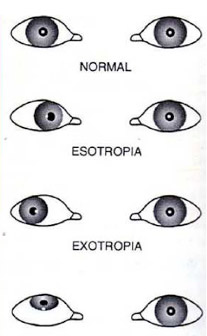What is Strabismus/Squint?
- Misalignment of the eyes which may be
- Horizontal
- Eso-deviation (In-turn of the eyes)
- Exo-deviation (out-turn of the eyes)
- Vertical
- Torsional

- Horizontal
The problem may be present at all times (constant) or may only appear at certain times, such as when the eyes are tired (intermittent).
- Clinical presentation
- Abnormal head posture
- Head tilt
- Face turn
- Facial asymmetry
Causes of Strabismus
There are several possible causes of strabismus, including weak eye muscles, heredity, cataract and nerve conditions.
Complications of Strabismus
- Acquired: diplopia/ double vision
- Before age 6: suppression of image from deviated eye
- Amblyopia/lazy eye
- Loss of 3D vision/depth perception
- If associated with neurological signs and poor vision must be investigated urgently
Strabismus Management
- Prescribe glasses if necessary
- Treat lazy eye: patching for children
- Eye exercises
- Prisms for diplopia/double vision
- If eye glasses and patching are not enough to straighten the eyes, you may need strabismus surgery. This surgery is designed to straighten the eyes, but it does not replace patching or eye glasses
- Consider surgery if
- Diplopia
- Abnormal head posture
- Worsening angles of deviation of strabismus
- Decreasing 3D vision
- Cosmetically unacceptable strabismus
The sooner the treatment is begun, the more likely the eyes will be properly realigned without developing amblyopia. Some types of strabismus can be treated medically and other types can only be corrected by surgery. Strabismus that develops early in childhood and is constant needs to be corrected surgically.
What happens during strabismus surgery?
During strabismus surgery the surgeon will realign or straighten the eyes by tightening or loosening the eye muscles on the outside of the eye. The eyes are not removed from the eye socket. Realigning the eyes helps them to work together, and may also improve the appearance.
Treating strabismus can help improve depth perception (the way the two eyes work together) and the field of vision. Many adult patients report improved self-esteem, communication skills, job opportunities, reading and driving.
To schedule an appointment or to know more about strabismus or squint treatment for your child, please call 6777 6058. Alternatively please send us an enquiry.
